Slide Guitar Techniques for Beginners: Essential Skills & Tips
Category: Guitar Gear
Master Slide Guitar Techniques: Your Beginner’s Guide
Are you eager to add the soulful, smooth sound of slide guitar to your playing but unsure where to start? Whether you're a novice guitarist intrigued by bluesy tones or a hobbyist wanting to expand your technique arsenal, learning slide guitar can be both exciting and challenging. This guide is tailored specifically for beginners like you who want clear, actionable steps to develop fundamental slide guitar skills without the overwhelm. You might have searched for tips on positioning the slide, tuning setups, or practical exercises but found content either too advanced or lacking structure. This post breaks down everything—from gear essentials and hand positioning to playing clean slides and mastering basic licks—with a logical flow that respects your learning pace and goals. We’ll also explore how slide technique integrates with different styles and gear setups to help you find your unique sound. Unlike generic tutorials, this article provides a comprehensive yet beginner-friendly roadmap to help you confidently express yourself using slide guitar. Dive in and transform your playing as you learn the key slide guitar fundamentals every aspiring guitarist must know.
- Master Slide Guitar Techniques: Your Beginner’s Guide
- Understanding Slide Guitar: What It Is and Why It Matters for Beginners
- Essential Gear for Slide Playing
- Tuning Options for Slide Guitar
- Proper Slide Holding and Hand Positioning
- Basic Sliding Techniques: Clean Slides, Vibrato, and Muting
- Simple Slide Guitar Exercises for Beginners
- Integrating Slide Guitar with Common Styles
- Using Effects and Gear to Enhance Your Slide Sound
- Common Challenges and How to Overcome Them
- Practice Tips and Resources for Continued Improvement
Understanding Slide Guitar: What It Is and Why It Matters for Beginners
Slide guitar is a unique guitar playing technique where a smooth object—commonly a metal or glass slide—is worn around a finger and glides over the strings instead of pressing them down against the fretboard. This method allows for seamless transitions between notes and creates the distinctive, expressive gliding sound that’s instantly recognizable in blues, country, rock, and even Hawaiian music. Unlike traditional fretting, slide guitar emphasizes continuous pitch variation and microtonal nuances, giving your playing a vocal-like, emotive quality.
The origins of slide guitar can be traced back to early African American blues musicians in the Mississippi Delta during the early 20th century. These pioneers developed the technique to mimic the human voice and impart deep emotional expression to their music, often using improvised tools such as bottlenecks or knife blades. Today, slide guitar remains vital across genres, celebrated for its rich tonal textures, sustain, and soulful phrasing that standard fretting cannot easily replicate. For beginners, understanding these fundamental aspects of slide guitar is essential as it opens up a new palette of sounds and expands creative possibilities beyond conventional guitar playing.
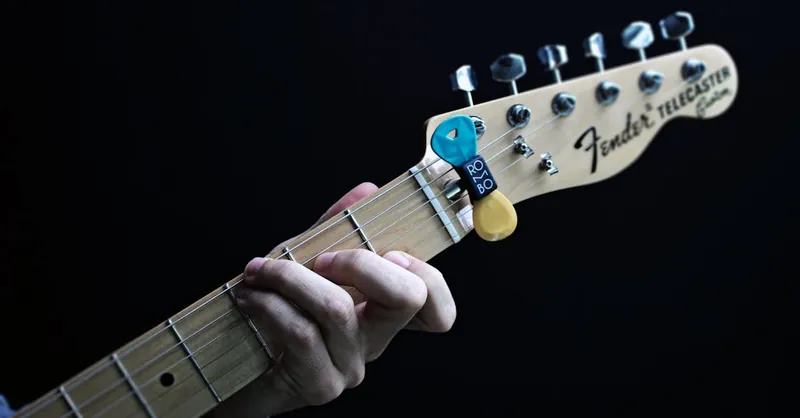
Image courtesy of ROMBO
Essential Gear for Slide Playing
Before you start mastering slide guitar techniques, having the right gear is crucial to achieving that classic, singing slide tone. The core piece of equipment is, naturally, the slide itself. Slides come in various materials, each influencing your sound and playability:
- Glass Slides – Known for their warm, smooth, and mellow tone, glass slides are favored in styles like blues and country. They produce a softer attack and are lighter on the fingers, ideal for beginners experimenting with expressive vibrato and subtle slides.
- Metal Slides – Typically made from brass or steel, metal slides deliver a brighter, louder, and more cutting tone with increased sustain. They work well in rock and heavier blues styles but require precise control to avoid unwanted string noise.
- Ceramic Slides – Offering a tonal middle ground, ceramic slides combine warmth with clarity and moderate sustain. They are durable and often preferred by players seeking versatility across genres.
Choosing the right guitar and strings complements the slide choice. Generally, guitars with a roundwound string set and a slightly higher action make sliding smoother and reduce buzzing. Many slide players opt for resonator guitars or instruments with a solid body like a Fender Telecaster, which respond well to slide dynamics and maintain clarity in the tone.
To optimize your setup for slide playing, consider the following tips:
- Raise your action slightly to prevent the slide from hitting the frets and causing unwanted noise.
- Use heavier gauge strings for better sustain and volume, as thinner strings tend to lose tone under the slide.
- Experiment with open tunings (such as Open G or Open D) since they allow full chords to ring out with single-note slides more easily.
With your gear dialed in—from slide material to guitar setup—you’ll be positioned to explore the rich sonic possibilities of slide guitar and develop your unique voice with confidence.

Image courtesy of Will Carter
Tuning Options for Slide Guitar
One of the foundational elements to mastering slide guitar is choosing the right tuning. Unlike standard tuning, open tunings are commonly used in slide playing because they allow you to play full, resonant chords with the slide and simplify fretboard navigation. This is especially helpful for beginners who want to focus on tone and slide accuracy without getting bogged down by complex fingerings.
Why Open Tunings Are Ideal for Slide Beginners
Open tunings create a major chord when you strum the open strings, so sliding the bar straight across any fret produces a clear, harmonically rich chord. This ease of chord formation:
- Reduces the need for precise finger placement, letting you emphasize smooth, gliding slide movements.
- Encourages exploring melodic slide phrases without worrying about hitting wrong notes.
- Makes it easier to imitate classic slide guitar styles from blues, country, and rock genres.
Two of the most popular and approachable open tunings for beginners are Open G (D-G-D-G-B-D) and Open D (D-A-D-F#-A-D). Open G tuning is favored by legends like Bonnie Raitt and The Rolling Stones’ Keith Richards, while Open D tuning offers a slightly darker, more resonant tone used by artists such as Robert Johnson and Duane Allman.
How to Tune Your Guitar to Common Slide Tunings
Here’s a step-by-step guide to quickly tune your guitar into these popular open tunings:
1. Open G Tuning (D-G-D-G-B-D)
- Tune your 6th string down from E to D.
- Leave the 5th string as G (standard).
- Leave the 4th string as D (standard).
- Leave the 3rd string as G (standard).
- Leave the 2nd string as B (standard).
- Tune the 1st string down from E to D.
2. Open D Tuning (D-A-D-F#-A-D)
- Tune your 6th string down from E to D.
- Tune your 5th string down from A to A (standard; no change).
- Tune your 4th string down from D to D (standard; no change).
- Tune your 3rd string down from G to F#.
- Tune your 2nd string down from B to A.
- Tune your 1st string down from E to D.
Before you start playing, always double-check your tuning with a reliable tuner for accuracy. Using open tunings not only enhances the natural resonance and sustain needed for slide playing but also encourages beginners to develop an intuitive understanding of chord shapes and slide movements. As you progress, experimenting with other tunings like Open E or double drop D will further expand your tonal palette and stylistic versatility.
By mastering these fundamental slide guitar tunings, you lay the groundwork for cleaner slides, richer chords, and more expressive phrasing—key elements that will elevate your slide guitar technique from day one.
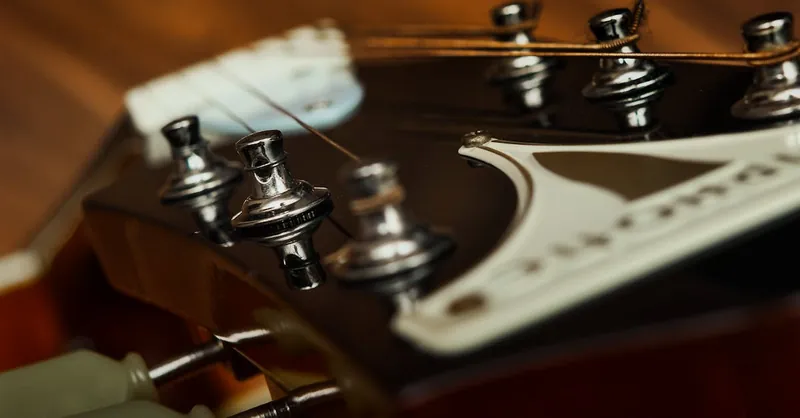
Image courtesy of Grzegorz Lewandowski
Proper Slide Holding and Hand Positioning
Mastering the proper way to hold the slide and optimize your hand positioning is a critical step for beginners aiming to achieve smooth, clean slide tones while minimizing unwanted string noise. The way you grip the slide and position your fingers directly affects your control over intonation, vibrato, and muting techniques—all essential for expressive slide playing.
How to Hold the Slide Correctly
Most slide players wear the slide on the ring finger or pinky of their fretting hand, which leaves the other fingers free for precise muting and fretting. Here’s how you can get started:
- Choose the right finger: Start by wearing the slide on your ring finger, as it provides a good balance of control and flexibility.
- Position the slide over the fingertip: The slide should cover the first joint of your finger, allowing it to glide smoothly along the strings without pressing too hard.
- Keep the slide slightly raised: Avoid pressing the slide down aggressively against the strings; instead, let it lightly rest to maintain natural sustain and avoid deadening the tone.
- Angle the slide parallel to the fretboard: Hold it so the slide remains parallel with the frets rather than angled, which helps prevent the slide from hitting the metal fret wires and creating unwanted buzz or clang.
Finger and Wrist Positioning for Smooth Slides
Achieving fluid slides without unwanted noise also depends on relaxed yet controlled finger and wrist positioning:
- Relax your fretting hand: Tension in the hand causes harsher tones and less control. Keep your hand loose to allow the slide to move smoothly.
- Use your wrist for movement, not just the fingers: Slide motion is more natural and precise when driven by a controlled wrist action, keeping the fingers in position to mute or fret as needed.
- Mute non-sliding strings with unused fingers: Use your index and middle fingers to lightly touch strings that you don't want to ring out. This prevents extraneous noise and ensures a cleaner sound.
- Anchor your palm lightly on the guitar body: Light contact provides stability without restricting movement or causing muffled tones.
By adopting these hand and slide-holding techniques early on, beginners can significantly reduce unwanted string buzz and improve pitch accuracy. Consistently practicing the right pressure and relaxed positioning enhances the signature singing quality of slide guitar—helping you capture the instrument’s emotive, vocal-like sound right from the start. Proper hand mechanics are the foundation for advanced slide techniques such as vibrato, microtonal bends, and dynamic control, making this step indispensable in your slide guitar journey.
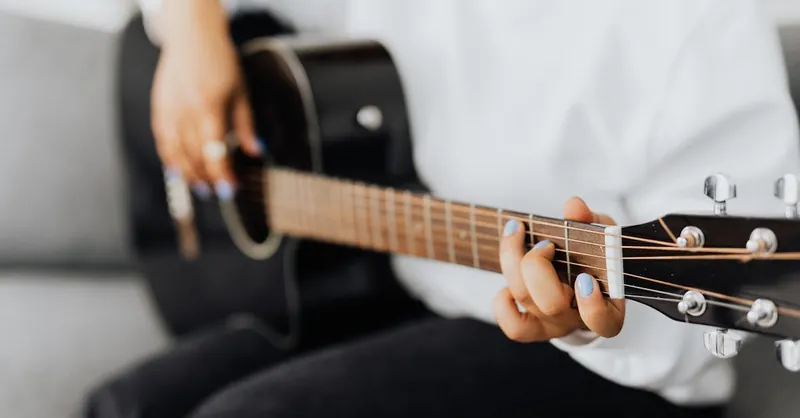
Image courtesy of Photo By: Kaboompics.com
Basic Sliding Techniques: Clean Slides, Vibrato, and Muting
Once you have your gear set up, your guitar properly tuned, and your slide securely positioned, it’s time to focus on the foundational sliding techniques that form the core of expressive slide guitar playing. Mastering clean slides, incorporating vibrato, and utilizing muting will dramatically improve your tone and control—key skills every beginner should prioritize.
Clean Slides: Achieving Smooth, Buzz-Free Transitions
A clean slide means moving the slide between notes without unwanted fret buzz or string noise, producing a clear, singing tone. To play clean slides:
- Use light, consistent pressure: Press the slide gently just enough to make contact with the string without pushing it down onto the frets.
- Maintain slide parallelism: Keep the slide parallel to the fret wires to avoid hitting them and creating clang or buzz.
- Slide fluidly and with intent: Move the slide smoothly between notes in one continuous motion rather than chopping or hesitating mid-slide.
- Practice sliding along a single string: Isolate one string at a time when practicing to develop precise pitch control and timing.
Adding Vibrato with the Slide for Expressive Dynamics
Vibrato is a subtle, wavering pitch modulation that brings emotion and life to slide playing. Applying vibrato with a slide differs from finger vibrato and involves gentle rocking or shaking motions of the slide itself.
- Start by holding the slide lightly and oscillate it slightly back and forth along the string axis, rather than up and down.
- Use your wrist or forearm to control the speed and width of the vibrato.
- Keep the motion subtle initially to avoid going off-pitch.
Incorporating vibrato adds a vocal-like quality to your playing that’s essential for blues, country, and soulful slide phrases.
Effective Muting to Reduce Fretboard Noise
One of the biggest challenges beginners face with slide guitar is managing the unwanted string noise caused by sympathetic vibrations and open strings ringing out unintentionally. Effective muting sharpens your tone and keeps your notes crisp.
- Use the fingers behind the slide (usually the index and middle fingers) to lightly mute strings that should not ring.
- Employ your picking hand palm to mute the lower (thicker) strings when necessary, especially during single-note runs.
- Practice combining both hands’ muting techniques as an integrated system to control strings during slides and transitions.
Mastering these basic sliding techniques—clean slides, vibrato, and muting—provides a sturdy foundation for developing smooth, expressive, and professional-sounding slide guitar playing. With consistent practice of these elements, you will minimize string noise, improve pitch accuracy, and capture the soulful, singing character that makes slide guitar so distinctive and captivating.
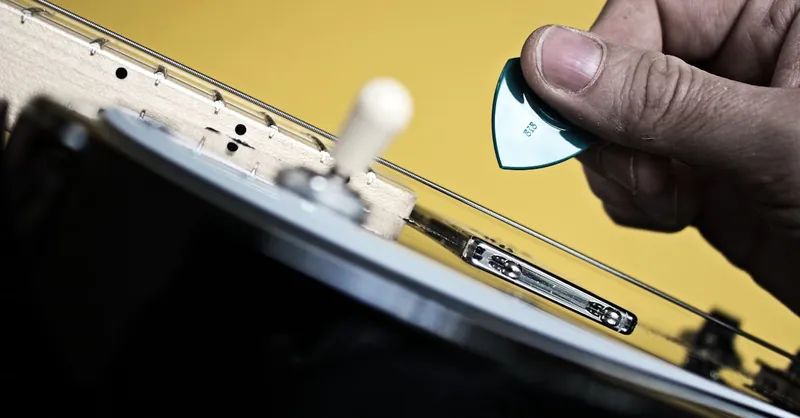
Image courtesy of ROMBO
Simple Slide Guitar Exercises for Beginners
To build confidence and accuracy with your slide guitar playing, it’s essential to practice simple, targeted exercises that focus on developing your sliding movements, note control, and rhythmic timing. These beginner-friendly exercises help you internalize smooth slide transitions while reinforcing clean tone production and muting techniques.
Exercise 1: Single-String Slide Control
Start by selecting an open string (such as the 3rd string, G) in your chosen open tuning.
- Place the slide gently over the open string and pick the note.
- Slowly slide the bar up to the 5th fret and hold the note steady.
- Slide back down smoothly to the open string.
- Focus on keeping the slide parallel to the frets and applying light, consistent pressure.
- Repeat this motion 5-10 times, aiming for clean tone and minimal fret buzz.
This exercise trains you to control smooth linear slides and develop a feel for accurate pitch placement without abrupt or choppy movements.
Exercise 2: Sliding Between Chord Shapes
Using open G or open D tuning, practice sliding between two simple chord positions:
- Place the slide on the open strings to play the open chord.
- Slide the bar up to the 3rd or 5th fret, creating a new chord shape.
- Strum the strings cleanly at each position.
- Repeat back and forth, working on smooth, even slides without excessive noise.
- Experiment with slightly varying the slide speed and pressure for dynamic control.
This helps develop your ability to combine chordal sliding with rhythmic strumming, enhancing your coordination and timing.
Exercise 3: Sliding Note Sequences with Muting
Choose a single string again and pick a simple note sequence, such as 0 (open), 2nd fret, and 4th fret.
- Play each note using the slide, making sure to stop cleanly on each fret.
- Use the fingers behind the slide to mute unused strings as you play.
- Incorporate light palm muting with your picking hand on the lower strings to reduce sympathetic noise.
- Maintain a steady tempo using a metronome or drum loop.
- Repeat until your slides and note changes sound clear and controlled.
This exercise emphasizes muting techniques and timely slide transitions, vital skills for creating polished slide guitar phrasing.
By dedicating just a few minutes daily to these structured exercises, you’ll accelerate your slide guitar progress. Consistent practice develops the necessary muscle memory and coordination, enabling you to play with greater confidence, fluidity, and precision—setting a strong foundation for more advanced slide techniques.
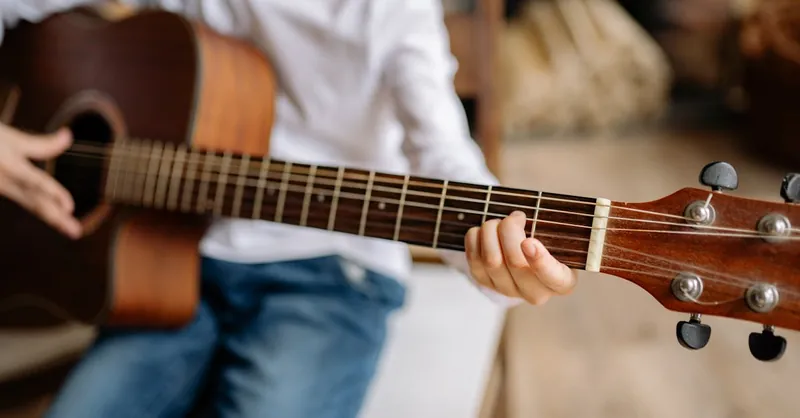
Image courtesy of Yan Krukau
Integrating Slide Guitar with Common Styles
Slide guitar is incredibly versatile and fits naturally into a variety of popular music styles, including blues, country, rock, and folk. For beginners, understanding how slide guitar complements these genres will provide valuable context and inspire your practice with style-appropriate riffs and phrasing.
Slide Guitar in Blues
Blues is undoubtedly the quintessential style for slide guitar. Its emotive, vocal-like qualities shine in the slow bends, microtonal shifts, and soulful vibrato characteristic of blues slide playing. Beginners can start with simple minor pentatonic or blues scale riffs played on one or two strings using slow, deliberate slides and subtle vibrato. Classic examples include the mournful phrases heard in Robert Johnson’s and Elmore James’s recordings, which often emphasize bottleneck slide techniques in open tunings like Open D or Open G.
Typical blues slide approaches for beginners include: - Sliding into the root note on the 5th or 7th fret of the G or B string. - Using a slow, expressive vibrato on sustained notes. - Playing call-and-response licks where the slide mimics vocal phrasing.
Slide Guitar in Country
In country music, slide guitar adds a twangy, melodic layer that enhances storytelling and rhythm. The technique is often cleaner and brighter than blues, favoring metal slides for a crisp attack and faster melodic runs. Beginners should try simple slide licks that complement common country chord progressions in open G tuning, incorporating alternating bass and melodic lines.
Country slide playing typically involves: - Quick slides paired with hammer-ons and pull-offs. - Using open strings in mixed picking patterns to maintain a rhythmic groove. - Integrating slide with pedal steel-inspired effects for a signature country vibe.
Slide Guitar in Rock
Rock music has embraced slide guitar to inject energy and grit, often blending blues influences with aggressive playing styles. For beginners exploring rock slide, metal or ceramic slides on electric guitars work well to cut through the mix. Classic rock riffs, like those of The Rolling Stones or The Black Keys, showcase how slide can add raw, expressive leads that complement overdriven tones.
Here's what to focus on when playing slide guitar in rock: - Combining slide phrases with distortion and wah pedals for tonal variety. - Incorporating rhythmic muting and dynamic strumming alongside slide runs. - Experimenting with faster slides and note transitions to match rock’s driving tempo.
Slide Guitar in Folk
Folk music leverages slide guitar for its intimate, lyrical qualities. The delicate use of slide creates subtle textures and spaciousness in fingerpicked arrangements. Beginners should approach folk slide with a focus on clarity and warmth, often using glass slides and simple melodies in open tunings like Open D.
Common folk slide techniques include: - Playing single-note melodies with clean slides and natural sustain. - Incorporating fingerpicking patterns alongside slide to maintain harmonic richness. - Using gentle vibrato and restrained muting for a smooth, airy feel.
By exploring slide guitar techniques within these diverse genres, beginners can not only develop foundational skills but also discover which styles resonate most with their personal sound. Integrating slide guitar thoughtfully into blues, country, rock, or folk playing opens up exciting new musical possibilities and keeps practice engaging and relevant.

Image courtesy of Marcelo Renda
Using Effects and Gear to Enhance Your Slide Sound
Once you’ve got the basics of slide guitar technique down, the next step is exploring effects and gear that can elevate your tone and help you craft a distinctive slide sound. The right combination of pedals, amp settings, and subtle effects can add depth, sustain, and ambiance—key elements for making your slide guitar sing with emotion and presence.
Essential Effects for Slide Guitar Beginners
- Reverb: A staple effect for slide guitar, reverb simulates the natural echo and space of a room or hall, giving your slide notes a lush, atmospheric quality. For beginners, a moderate reverb setting enhances sustain and smooths the attack without washing out the clarity of your slides.
- Delay: Delay pedals add repeating echoes of your notes, which can thicken your sound and emphasize phrasing. A short slapback delay is particularly effective for blues and country styles, making your slide lines sound more dynamic and textured.
- Compression: Compression evens out volume levels by boosting quieter notes and taming louder ones, resulting in a more consistent and polished slide tone. It helps maintain sustain, so your notes linger longer, making bends and vibrato more expressive.
Amp Settings and Pedal Tips for Slide Guitar
To optimize your amp settings for slide guitar: 1. Keep your gain moderate. Too much distortion can obscure the smoothness and clarity of your slide tone. Aim for a clean to mildly overdriven sound that preserves note definition. 2. Boost mid frequencies. Slide guitar’s vocal-like quality benefits from emphasizing the midrange, which enhances the presence and warmth of your playing. 3. Set a moderate treble. Enough treble is necessary for articulation, but avoid overly bright tones that might make slides sound harsh or brittle.
For beginners selecting pedals: - Start with a simple reverb pedal—spring or hall-type reverbs work well to add organic space. - Consider a dynamic compressor pedal to boost sustain without squashing your tone. - A basic delay pedal with adjustable time and mix knobs gives you flexibility without complexity.
Experiment with stacking effects in small increments, as too many effects or extreme settings can muddy your tone and make clean slide playing difficult. Combining your slide technique with carefully chosen gear and effects not only enhances your overall sound but also inspires creativity by allowing you to explore new textures and musical expressions right from the start.

Image courtesy of Kelly
Common Challenges and How to Overcome Them
Learning slide guitar as a beginner comes with its unique set of challenges, but with targeted practice and smart techniques, you can overcome these obstacles and progress smoothly. Here are some of the most common issues you might face, along with actionable solutions to help you build confidence and improve your slide playing.
Intonation Issues: Hitting the Right Pitch
One of the biggest hurdles for beginners is mastering accurate intonation with the slide, as the slightest variation in pressure or slide position can cause notes to sound sharp or flat. To improve pitch accuracy:
- Keep the slide centered directly above the fret wire rather than between frets. Playing directly over the fret gives the clearest and most in-tune note.
- Use light and consistent pressure with the slide. Pressing too hard can bend the string unnaturally and throw off pitch.
- Practice slow, deliberate slides along one string while checking your pitch with a tuner to train your ear.
- Incorporate vibrato exercises to learn controlled microtonal variations, helping your fingers “feel” the correct slide placement.
Patience and repetition are essential here; over time, muscle memory will develop, allowing your intonation to become more natural and reliable.
Finger Soreness and Fatigue: Building Endurance Safely
Beginners often experience finger soreness from holding and sliding with a metal or glass tube—especially when first adopting proper slide pressure and hand positioning. To manage discomfort and build finger strength:
- Begin with short, frequent practice sessions rather than long, strenuous ones.
- Choose a lighter glass slide initially, which exerts less pressure and feels more comfortable.
- Warm up your hands with finger stretches and hand exercises before playing to increase flexibility.
- Gradually increase slide playing time to build endurance without overstraining muscles.
- Use moisturizing lotion if your skin becomes dry or irritated from friction.
Taking care of your hands and maintaining a relaxed grip prevents tension, allowing you to play longer and more fluidly without pain.
Controlling Slide Pressure: Avoiding Buzz and Muting Noise
Applying the right amount of pressure with your slide is critical to achieving a clean tone free of fret buzz or unwanted string noise. Many beginners either press too hard, causing deadened notes, or too lightly, producing buzzing. To gain better control:
- Focus on a "just enough" mentality: Press the slide gently until the note rings out clearly without the slide touching the fretboard.
- Keep the slide parallel to the frets to minimize clang or buzz caused by sliding across fret edges.
- Use muting techniques with your unused fingers and picking hand palm to silence open or sympathetic strings.
- Practice with a metronome, concentrating on clean note attacks and releases to develop consistent slide pressure and timing.
By honing precise slide pressure and muting control, beginners can produce smooth, articulate tones that showcase the slide guitar’s emotional expressiveness—without the distraction of excess noise.
Addressing these common beginner challenges head-on will greatly enhance your slide guitar journey. With conscious practice on intonation, finger care, and slide pressure, you'll make noticeable improvements in tone quality, playability, and overall musical expression. These foundational skills empower you to unlock the full magic of slide guitar as you advance toward more complex styles and techniques.
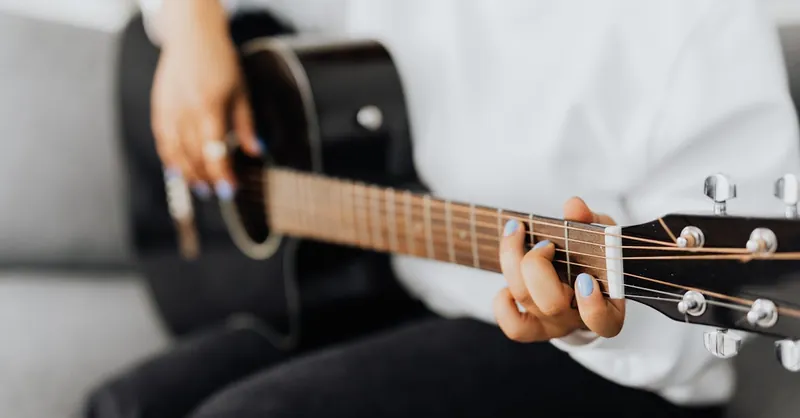
Image courtesy of Photo By: Kaboompics.com
Practice Tips and Resources for Continued Improvement
Consistent, focused practice is the key to mastering slide guitar as a beginner. To make the most of your practice sessions and accelerate your improvement, develop a structured routine that balances technical exercises, musical application, and listening. Here are some essential practice tips to help you stay motivated and progress effectively:
- Set Clear Goals: Define specific objectives for each session—whether it’s improving slide intonation, mastering a particular lick, or working on muting techniques. Clear goals ensure purposeful practice and measurable progress.
- Use a Metronome: Practicing with a metronome enhances your timing and rhythmic precision, crucial for tight slide transitions and clean phrasing across various styles.
- Incorporate Backing Tracks: Playing along with blues, country, or rock backing tracks reinforces your ability to apply slide techniques musically, develop improvisational skills, and build confidence.
- Record Yourself Regularly: Listening back allows you to identify areas for improvement in tone, timing, and clarity, making your practice more self-aware and effective.
- Keep Sessions Short and Consistent: Frequent, focused daily sessions (15–30 minutes) are more productive than occasional long practices, reducing fatigue and encouraging steady skill development.
Recommended Learning Materials and Online Communities
Exploring quality resources can provide structured guidance and inspiration as you navigate the slide guitar learning curve. Consider incorporating these into your practice toolkit:
- Books: Titles such as Slide Guitar for Beginners by Guitar World or Blues You Can Use by John Ganapes offer step-by-step lessons and exercises tailored for slide players.
- Video Tutorials: YouTube channels like JustinGuitar and Marty Music provide free, beginner-focused slide guitar lessons covering essential techniques and popular riffs.
- Online Courses: Platforms like TrueFire and Udemy feature comprehensive slide guitar courses that blend theory, technique, and stylistic applications.
- Tablature and Sheet Music: Websites like Ultimate Guitar and Songsterr offer extensive slide guitar tabs for blues, rock, and country standards, supporting learning by replication.
Joining active online communities and forums can further enrich your journey:
- Reddit r/slideguitar: A vibrant community where slide guitarists share tips, videos, gear reviews, and answer beginner questions.
- The Gear Page: A forum with dedicated slide guitar threads for gear recommendations, technique discussions, and player support.
- Facebook Groups: Look for groups like “Slide Guitar Players” or genre-specific communities that offer peer feedback and motivation.
Tapping into these resources and communities not only broadens your knowledge but also keeps your enthusiasm high by connecting you with fellow slide guitar enthusiasts worldwide.
By cultivating disciplined practice habits and leveraging trusted learning materials alongside supportive online networks, you’ll continually refine your slide guitar skills. This holistic approach ensures sustained improvement and deepens your connection with the soulful art of slide guitar playing.

Image courtesy of Yan Krukau
